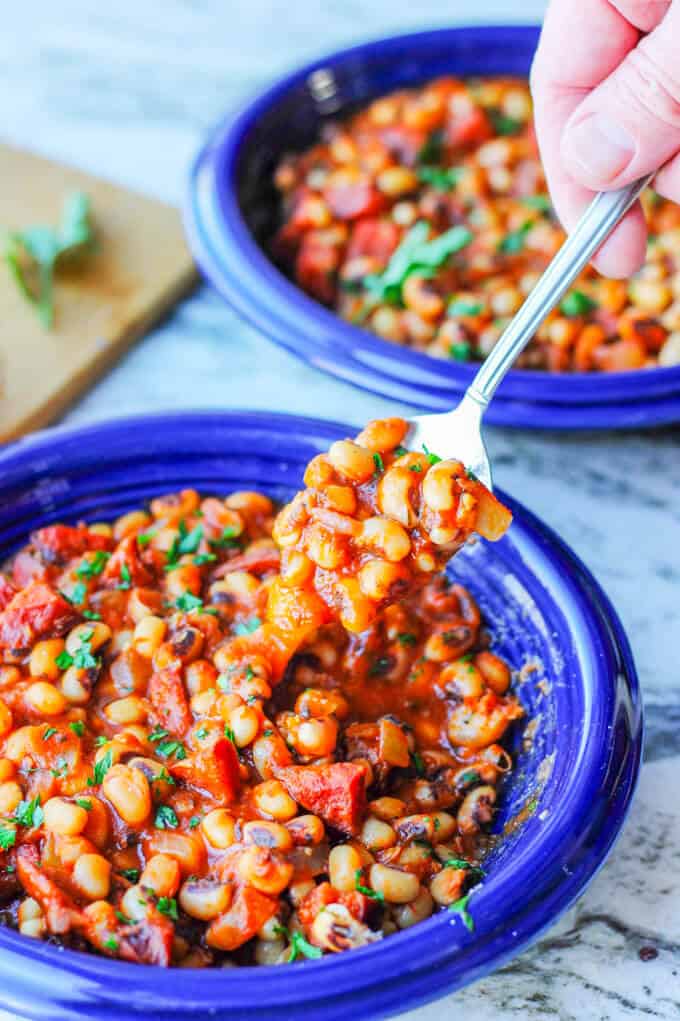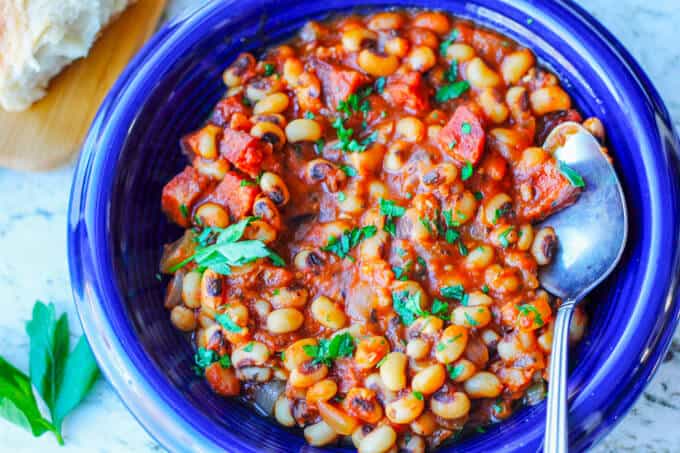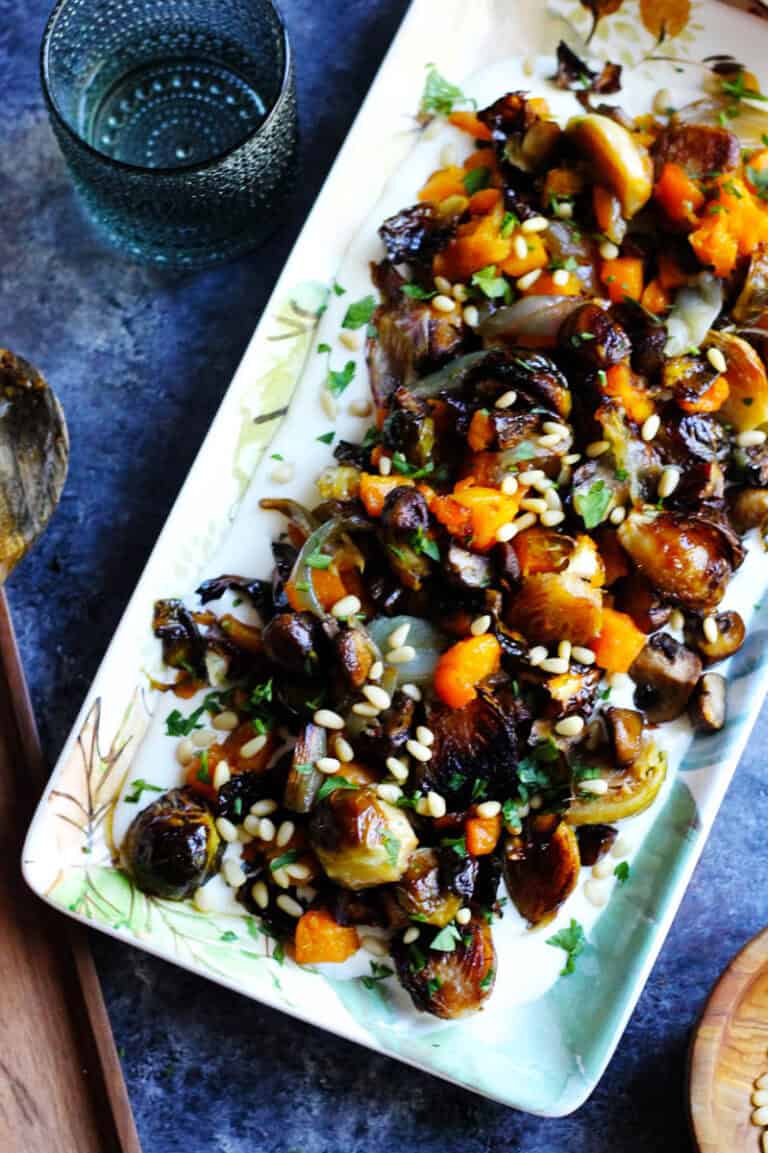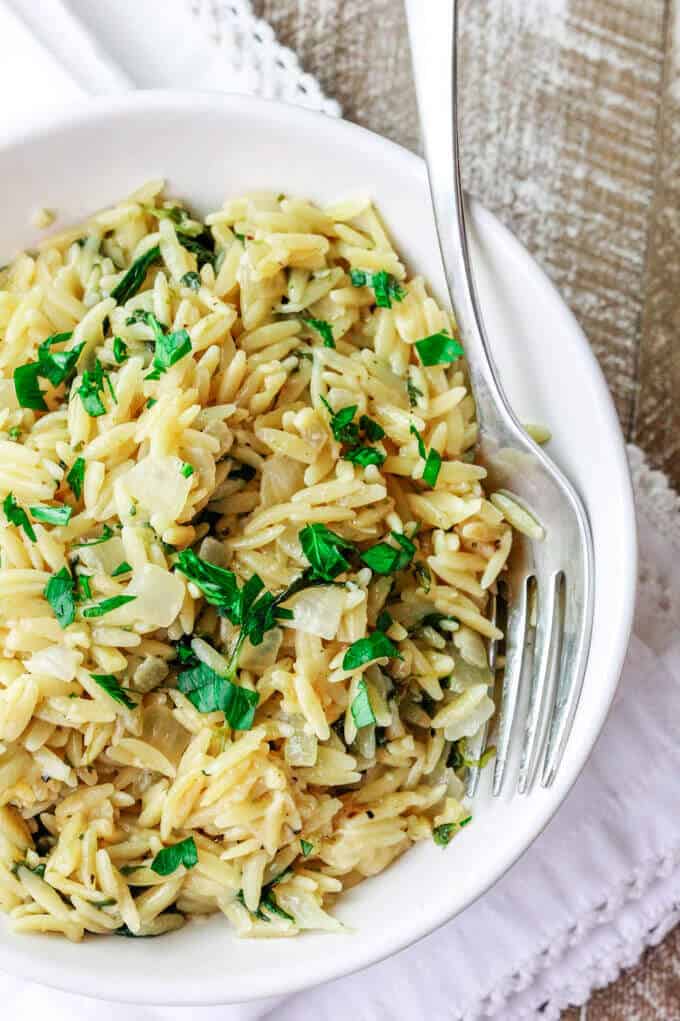Breton Beans (Fasolka po Bretonsku) w/ Kielbasa
This post may contain affiliate links which won’t change your price but will share some commission.
Breton Beans (Fasolka po Bretonsku) with Kielbasa and Tomatoes is a super comforting dish for these cold winter days. Use black eyed peas to welcome New Year the traditional way.

What are Breton Beans
Breton Beans, or in Polish “Fasolka po Bretonsku”, is a very popular dish in Poland. However, I don’t think it originally comes from Poland. Based on the name I have to assume that it comes from Brittany, but because it is so widely served throughout, I can honestly say that it is a traditional Polish dish. I often receive lots of requests to put more Polish recipes; so here is yet another one – a very popular Breton Beans recipe.
For the original Polish Breton Beans I would suggest using large white beans which you soak over night and then you cook the next day for at least an hour and a half. I assume these are the preferred bean because they’re the most abundant in Poland. But this dish is so versatile that you can really use any type of beans you’d like.

I decided to use these black eyed peas and served it for dinner on the New Year’s day. Despite their identity crisis …. black eyed peas are actually beans. And apparently there’s a tradition to eat black eyed peas on New Year’s day.
I thought it was just a Greek tradition, but I have just learned that it’s also a southern tradition. It’s believed that eating black eyed peas will bring prosperity in the New Year (who knew?). Well, I’m all for prosperity, so I decided to give it a try and I promise to circle back at the end of the year and either confirm or debunk this superstition.

In Poland we don’t really have a special dish for the New Year, but obviously some countries do. In fact, my Hungarian friend asked me about it the other day, and she told me that their tradition is to eat lentils. I found it fascinating and decided to do some research into these New Years culinary traditions. And so it was that that we ended up eating black eyed peas last night.
As I said above, this Breton Beans dish is very versatile:
- You can make it very meaty and add bacon, ham or more sausage; or you make it vegan by skipping the meat altoghether;
- You can also use different kind of beans: large fava beans, kidney beans, northern beans, black eyed peas, etc…
- Or you can make a shorter version and use canned beans instead of dried.
For this Breton Beans recipe I used:
- Dried black eyed peas that I soaked over night;
- Polish smoked kielbasa;
- Onions;
- Garlic;
- Crushed Tomatoes;
- Tomato Paste;
- Marjoram (you need to add it to make it easier to digest beans);
- Bay leave;
- Allspice;
- Salt & Pepper;
- Cayenne pepper (not traditionally found in the Polish version but my husband requested a little heat)
- Water.

I serve this Breton Beans dish with a crusty bread. You can make your own homemade crusty bread. It’s super easy and delicious. Or you could also serve it with a side of rice.
If you are interested in a history of black eyed peas on New Year’s day, this article can give you some more information. And if you want to cook some real Southern black eyed peas, I found this recipe interesting. Do you have any traditions for New Year’s Day? What was served for dinner in your house?

If you’re hungry for more Polish recipes here are few of my favorites:
Dill Pickle Soup (Zupa Ogorkowa)
Sauerkraut and Mushroom Pierogi

Breton Beans (Fasolka po Bretonsku) with Kielbasa and Tomatoes
Ingredients
- 1 cup Beans Dried
- 1 Onion medium, sweet, chopped
- 2 cloves Garlic chopped
- 1 cup Kielbasa Smoked Polish Sausage, cubed
- 2 cups Crushed Tomatoes
- 1 tbsp Tomato Paste
- 3 teaspoon Marjoram
- 1 Bay Leaf
- 3 Allspice
- 6 cups Water
- Salt & Pepper to taste
- Pinch Cayenne Pepper optional
- 1 tbsp butter ghee or cooking oil
- 1 teaspoon Parsley chopped
Instructions
- Add beans to a bowl and cover with lots of water and soak overnight.
- Rinse the beans and add them to the pot with 6 cups of water. Bring to boil, cover and cook for about an hour to an hour and a half. The cooking time depends on beans. They should be soft but not overcooked;
- In a frying pan heat up one tablespoon of butter or ghee or cooking oil and add cubed kielbasa (sausage) and cook until golden brown for about 5 minutes;
- Once the sausage is cooked remove from the pan and set aside;
- Add onions to the same pan; if needed add extra fat; cook until golden and soft, for about 3-4 minutes; add garlic and cook for another minute.
- Once the beans are cooked add sausage and onions/garlic mixture to the pot with the beans;
- Add bay leaf, allspice, crushed tomatoes, tomato paste, marjoram, half a teaspoon of salt and freshly ground pepper and cook for about 15 minutes;
- Check for seasoning, add more salt and pepper if needed; optionally add pinch of cayenne for some heat; sprinkle with fresh parsley and serve with crusty bread.
Notes
Nutrition
Read about the author Edyta here or follow Eating European on social media: Facebook, Instagram, Pinterest, and Twitter.
[mc4wp_form id=”6774″]
If you like this recipe you may also like these Polish recipes:
Authentic Polish Pierogi with Potatoes and Cheese



Traditional Polish Dill Pickle Soup








Looks delicious – I loved kielbasa!!! and now i have to try your pierogies too!
Thanks Heather. I hope you will like them 🙂
I was just thinking of making beans with sausage for supper! It is so warming and filling.
Great you come along my recipe. i hope you will make it and you will like it 🙂
Love how versatile this recipe is and that there is a vegan option! My husband would really love this for dinner!
Thanks Jessica, It is very versatile and it can be done vegan. You can even add different kind of beans or lentils.
Black eyed peas are a big tradition for the New Year in the South. I always make Hoppin John, but this looks mighty tasty too.
I would love to try Hoppin John!
I made this today and it was fantastic! Perfect after a run in the dark, cold and foggy winter here in the UK!
Oh my! I could go for a dish of that right now! And, I’m southern and didn’t realize the black eyed pea tradition for New Years was practiced anywhere else. Interesting.
Thanks Pam!